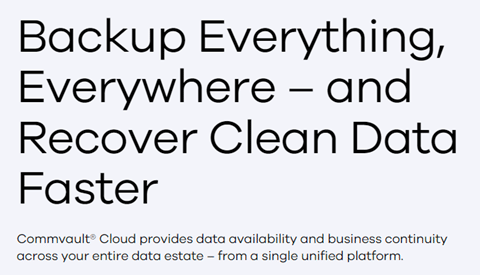This post is Part One of a two-part series that examines (1) the forces driving and opposing tech stack consolidation in enterprise data protection and (2), how those market dynamics have shaped the data protection monitoring market (Part Two).
The enterprise data protection market is filled with a diverse cast of players, ranging from pioneers like Dell and Veritas, to modern leaders like Veeam, Rubrik, Cohesity, and Commvault, and a long tail of other players.
In the context of ongoing multi-cloud migrations, surging ransomware incidents, and increasingly stringent data privacy laws, data protection software providers have had to adapt. In many cases, that has meant aggressively enhancing products to align with trends (e.g., AI-everything, cloud-first, ransomware/malware detection) and tap into cybersecurity budgets that are expected to grow 14% in 2024 (Gartner).
Let’s look at a few marketing claims from some of the leaders:

Commvault – https://www.commvault.com/

Veeam – https://www.veeam.com

Veritas – https://www.veritas.com/

Cohesity – https://www.cohesity.com/products/dataprotect/

Dell – https://www.dell.com/en-us/dt/data-protection/index.htm
“Everything… Everywhere… Versatility… Comprehensive… all of Your Data…”
A common goal among leading data protection providers is to dominate their customers’ environments — to be their one-stop shop or something like it.
To become their customers’ all-in-one data protection platform is a sensible goal, but just how close is that vision to today’s reality?
Complexity is the Reality
As much as many IT professionals would like to consolidate down to one or two backup products, it rarely happens for multinational enterprises. Here are a few of the reasons why it’s so rare:
- Vendor diversification is a strategy…
-
- …for security: Many enterprises intentionally maintain a disparate and heterogeneous data protection environment to boost resilience in the event of a cyberattack (e.g., ransomware).
- …and flexibility: Maintaining several backup products in the environment can help avoid vendor lock-in and ensure leverage when it comes to pricing and renewal negotiations.
- There is poor alignment between security, DR, cloud backup, and on-prem backup teams. According to a recent research brief from Veeam, leaders from those collaborative functions rarely believed they were “well aligned with each other on either strategy requirements or implementation/usage of technologies.” Without this alignment, tech stack consolidation is nearly impossible.
- Multi-cloud is a consensus best practice. Organizations intentionally use multiple public cloud platforms (for many reasons) and often use different backup products to suit how the organization is using each cloud platform. For example, an organization might use Druva for AWS backups and Commvault for Azure backups because of perceived differences in how each product supports different cloud assets.
- Cloud/multi-cloud migrations take time. It can take years for enterprise multi-cloud migrations to complete, resulting in years of complex and highly dynamic hybrid environments. As “lift and shift” operations slowly transform data environments, it is often easiest for IT teams to leave existing workflows and tools alone. This means plenty of legacy and on-prem backup products alongside modern cloud tools.
- Consolidation onto a single platform is difficult and risky. The decision to consolidate down to a single leading data protection platform can make sense when it is made, but circumstances can change quickly – both during and after lengthy and costly migration efforts. For example, the provider could get acquired and have its product roadmap suspended or scrapped altogether, derailing the plan to consolidate while wasting time and money.
- M&A = more tools. Many enterprises regularly acquire other companies (and their data assets). This results in a proliferation of data and the backup tools that are protecting it, creating unique challenges that require the right tools.
- Specialty backup tools work better for specialty use cases. As “comprehensive” as the leading data protection platforms might be, they are not always the best at protecting specific assets an organization might deem important. Here are a few examples of niche backup products that specialize in very specific data assets:
In summary, there are multiple contributing factors that have resulted in today’s enterprise data protection reality: complex, heterogeneous backup environments with disparate technologies supporting them.
Facing the Complex Reality
In Part Two of this series (now available), we’ll look at how monitoring tools address the modern reality of complex backup environments and compare how legacy and modern monitoring tools differ in their approaches. Subscribe to the Bocada Insights monthly newsletter to make sure you don’t miss this and future data protection insights.

